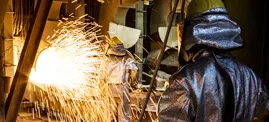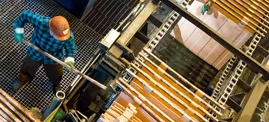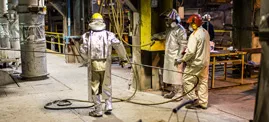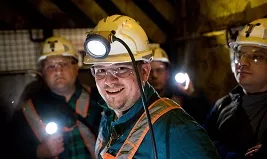General Information
The Rudna mine is located in the Polish region of Lower Silesia, north of the city of Polkowice. It mainly operates in the Rudna deposit, but it also carries out access and exploitation works in the Sieroszowice, Głogów Głęboki-Przemysłowy and Lubin-Małomice deposits. The recoverable resources of the Rudna mine (as at 31.12.2017) in its four deposits amount to 384 million tonnes of copper ore. The average copper content is 1.95%, the average silver content is 59.71 g/Mg.
Among the Polish copper deposits operated by KGHM, Rudna deposit stands out the thickest orebody – up to even over a dozen meters; average thickness of the Rudna deposit is over four meters nowadays and over 70% of resources are over three meters thick. In the Rudna deposit, the dominant part consists of sandstone ores – around 80% of resources, carbonate ores represent approximately 15% and copper-bearing shale only 5% of total deposit mass. Copper-bearing shales contain the highest grade of copper – over 6% of Cu. The depth of deposition of the copper orebody in the Rudna deposit ranges from 844 m up to 1250 m, and for Głogów Głęboki-Przemysłowy – up to 1385 m in depth.
History
The Rudna mine was designed on a grand scale – its technical and technologically solutions are different than previously used in the Copper Belt. However, the experience gained during the construction and exploitation of the Lubin and Polkowice mines was used.
The Rudna mine started its mining operations in 1974. It was a bold project, but it met all the expectations, as reflected in the dynamic increase in output: in the first year of its operation, the output was 1.9 million tonnes of ore, but by 1983 this had increased to 11.3 million tonnes.
The current average production capacity is around 12 million tonnes of ore per year. Thanks to the Rudna infrastructure, we have access to the Głogów Głęboki-Przemysłowy deposit. Accessing these resources is one of the priority projects implemented by KGHM.
Production
Mining in the Rudna mine is carried out in three mining regions:
- GG-1,
- GG-2,
- GG-3.
There are ten operating shafts with depths from 941 to 1244 metres – three haulage shafts, four shafts for ventilation and three shafts for personnel and material transport. The production process is based on the room-and-pillar method. The extraction of ore involves blasting, during both the preparatory-access and production phases. Loading/haulage machinery and ore haulage vehicles are used to remove the ore from the working faces. Conveyor belts are used for the main horizontal transport.





